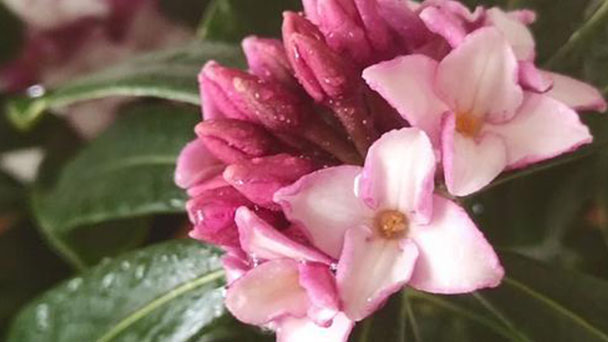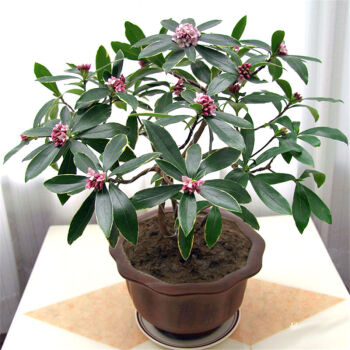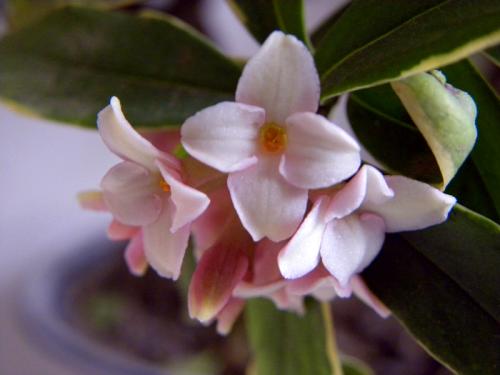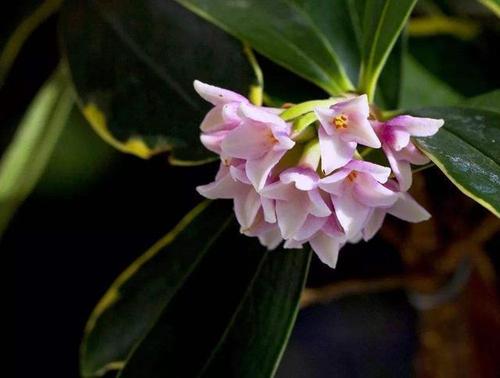Daphne odora profile
Written by Maggie
Jan 06 2021

Daphne Odora is a small evergreen shrub. It is originally from South of the Yangtze River in China and Japan. It has medicinal value. Daphne Odora, which is originally from China and Japan, is a famous traditional Chinese flower. Daphne Odora blossoms early in spring, fragrant fragrance.
Daphne odora picture

Daphne odora characteristics
Daphne Odora is an evergreen erect shrub; Branchlets are stout, usually bifid branched, branchlets sub cylindrical, purple-red or purple-brown, glabrous. Leaves are alternate, papery, oblong or ovate-elliptic, 7-13 cm long and 2.5-5 cm wide, apex obtuse, base cuneate, margin entire, green above, light green below, glabrous on both surfaces, lateral veins 7-13 pairs, with middle veins conspicuously raised on both surfaces; The petiole is stout, 4-10 mm long, sparsely puberulent or glabrous.
Daphne Odora flowers mauve-red on the outside, fleshy red on the inside, glabrous, with several to 12 forming the terminal head; Bracts are lanceolate or ovate-lanceolate, 5-8 mm long, 2-3 mm wide, glabrous, veins conspicuously raised; The calyx is bobbed, 6-10 mm long, glabrous, lobes 4, heart-shaped ovate or ovate-lanceolate, base heart-shaped, as long as or longer than calyx tube; Stamens in 8,2 round, stamens in lower round born above middle of calyx tube, anthers 1/2 extending from throat of calyx tube, filaments 0.7 mm long, anthers oblong, 2 mm long; The ovary is oblong, glabrous, apically obtuse, style short, stigma capitate. The fruit is red.
Daphne Odora flowering from March to May and fruiting from July to August.

Daphne odora habits
Daphne Odora likes semi-shade and ventilated environments, afraid of exposure to the sun, not resistant to accumulated drought. daphne odora likes fertile and moist but well drained slightly acidic loam, strong germination, pruning resistance.
Daphne Odora likes warm, ventilated, half dry, half wet, avoid much water; Daphne Odora likes medium acid, love loam, want to plant shallow soil, avoid planted deep, like scattered light, love long light, semi-shade, avoid strong light; Daphne Odora likes n, P and k, love base fertilizer, thin fertilizer frequent application, avoid fertilizer touch flowers. Potted Daphne Odora, it is advisable to use loose and fertile leaf rot soil rich in humus and acid, mixed with appropriate amounts of river sand and stale cake fertilizer.
Daphne Odora root is succulent, so special attention should be paid to control watering at ordinary times. For example, overwatering and long-term overwetting of the basin and soil may easily cause root rot. After the rain, the water must be promptly poured out of the basin.
Although Daphne Odora prefers half shade, winter and spring should be placed in the environment exposed to sunlight. During the growth period, if the sunlight is sufficient, it is suitable for fertilization, which can make the branches, meat and leaves die, and the flowers are colorful and fragrant. In summer, it should be placed in the shade with good ventilation, and spray water to cool down when it is hot. Daphne Odora is more fattening and should be watered with thin liquid fertilizer every 10 days or so during the growing season. Before and after flowering, it should be applied to thin cake fertilizer water. After frost's descent, move into the indoor sunny place, keep the room temperature at 5℃ or so, control watering; Basin soil water content control in about 45%, and it can safely winter.
In addition, Daphne Odora has a cluster of branches, strong germination, pruning resistance, and pruning after flowering.
Distribution range of Daphne Odora
Daphne Odora, a famous traditional Chinese flower, is originally from China and Japan. Daphne Odora is distributed in the south of the Yangtze River basin provinces, Japan also distributed. Ganzhou city of Jiangxi Province listed it as "city flower".

Latest Updated
- Benefits of Bugleweed - 7 Science-backed Health Benefits
- Bugleweed Dangers & Side Effects - Is It Poisonous?
- How to Plant Evergreen Trees - What You Should Know
- When to Plant Evergreens - Grow Guide for Evergreen Trees
- 12 Wonderful Evergreen Shrubs for Your Garden
- 12 Popular Evergreen Plants with Pictures for Beginners
- When And How To Prune A Lilac Bush Like a Pro
- How to Grow & Care for Lilac Vine (Hardenbergia Violacea)
- Japanese Lilac Tree (Syringa Reticulata) Care & Propagation Guide
- Shumard Oak Pros and Cons - What to Know
Popular Articles
- Winter maintenance of Antirrhinum Majus
- How to Grow Terminalia Mantaly Tree
- How to Grow and Care for Crossostephium Chinense
- How to grow Antirrhinum Majus in spring
- Peristeria Elata (Dove Orchid) Profile: Info & Care Guide
- Underwatered Snake Plant (Sansevieria Trifasciata) - Signs And How To Fix
- How to Care for Brazilian Jasmine Plant (Mandevilla Sanderi)
- How to Grow & Care for Graptopetalum Purple Delight in Summer
- Rosa Chinensis (China Rose): Plant Growing & Care Tips
- How to Care for Baby Sun Rose (Aptenia Cordifolia)